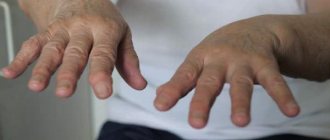Cavernous sinus thrombosis (CS) is a rare disease that occurs as a result of infection with further inflammatory process in the body. The disease is often accompanied by pathological changes and severe complications that negatively affect human health.
This form of thrombosis can affect the brain and lead to death. Such negative developments can be prevented with the help of timely diagnostic and therapeutic measures.
What is cavernous sinus thrombosis?
Thrombosis of the cavernous (cavernous) sinus is a blockage of formations (sinuses) at the base of the skull by a blood clot. The disease is the result of the spread of an inflammatory infectious process in the body under the influence of accompanying factors.
The cavernous sinuses drain blood from the facial veins. These include the 3rd, 4th, 6th and partially 5th pairs of cranial nerves, which are susceptible to pathological changes during thrombus formation during TCS. As a result of a malfunction of the cavernous sinus, circulatory problems occur due to blood clots obstructing blood flow. This process can lead to serious consequences, one of which is damage to the vascular wall, affecting the functioning of the entire body.
ATTENTION!
Thrombosis of the cavernous sinus is a deadly pathology, which without timely therapeutic intervention can lead to death of the brain and the formation of cavities in its area.
Sinuses of the dura mater
The sinuses of the dura mater, sinus durae matris, are peculiar venous vessels, the walls of which are formed by the sheets of the dura mater. What the dural sinuses have in common with venous vessels is that both the inner surface of the veins and the inner surface of the sinuses are lined with endothelium. The difference between veins and sinuses is, firstly, the structure of their walls; the wall of the veins is elastic, consists of three layers, their lumen collapses when cut, the walls of the sinuses are tightly stretched, formed by strong fibrous tissue with an admixture of elastic fibers, the lumen of the sinuses gapes when cut; secondly, venous vessels have valves, but sinuses do not contain valves. In the cavity of the sinuses there is a number of fibrous bars and incomplete septa covered with endothelium, spreading from one wall to another and reaching significant development in some sinuses. The walls of sinuses, unlike veins, do not contain muscle elements.
The sinuses of the dura mater include:
- Superior sagittal sinus, sinus sagittalis superior. It has a triangular lumen and runs along the upper edge of the falx cerebri (the process of the dura mater) from the crista galli to the protuberantia occipitalis interna, where it most often flows into the right transverse sinus, sinus transversus dexter.
- The inferior sagittal sinus, sinus sagittalis inferior, runs along the entire lower edge of the falx cerebri. At the lower edge of the falx, the inferior sagittal sinus joins the straight sinus, sinus rectus.
- The straight sinus, sinus rectus, is located along the junction of the falx cerebellum with the tentorium cerebellum, tentorium cerebelli. It has a quadrangular shape and is formed by the layers of the dura mater of the tentorium cerebellum. The sinus runs from the posterior edge of the inferior sagittal sinus to the internal occipital protuberance, where it joins the transverse sinus.
- The transverse sinus, sinus transversus, paired, lies in the transverse groove of the skull bones along the posterior edge of the tentorium of the cerebellum. From the area of the internal occipital protrusion, where both sinuses widely communicate with each other, they are directed outward to the area of the mastoid angle of the parietal bone. Every one here
- The occipital sinus, sinus occipitalis, runs deep into the margin of the falx cerebellum, falx cerebelli, along the internal occipital crest from the internal occipital protuberance to the foramen magnum. Here it splits in the form of marginal sinuses, which bypass the foramen magnum on the left and right, flow into the sigmoid sinus, less often - directly into the superior bulb of the jugular vein. The drainage of the sinuses, confluens sinuum, is located in the area of the internal occipital protrusion; only in a third of cases do they connect here the following sines: both sinus transve
- Cavernous sinus, sinus cavernosus, paired, lies on the lateral surfaces of the body of the sphenoid bone. Its lumen has an irregular triangular shape.
- Intercavernous sinuses, sinus intercavernosi, are located around the sella turcica and the pituitary gland. These sinuses connect both cavernous sinuses and together form a closed venous ring.
- The pterygoparietal sinus, sinus sphenoparietalis, paired, is located along the small wings of the sphenoid bone; drains into the cavernous sinus.
- The superior petrosal sinus, sinus petrosus superior, is paired, lies in the superior petrosal groove of the temporal bone and extends from the cavernous sinus, reaching the sigmoid sinus with its posterior edge.
- The lower stony sinus, sinus petrosus inferior, paired, lies in the lower stony groove of the occipital and temporal bones. The sinus runs from the posterior edge of the cavernous sinus to the superior bulb of the jugular vein.
- Basilar plexus, plexus hasilaris. lies in the area of the slope of the sphenoid and occipital bones. It looks like a network that connects both cavernous sinuses and both inferior petrosal sinuses, and below it connects with the internal vertebral venous plexus, plexus venosus vertebralis internus
from them passes into the sigmoid sinus, sinus sigmoideus, which lies in the groove of the sigmoid sinus of the temporal bone and through the jugular foramen passes into the superior bulb of the jugular vein, bulbus v. jugularis superior.
rsus, sinus sagittalis superior, sinus rectus
The name of the sinus (cavernous) is due to the large number of connective tissue septa that penetrate its cavity, giving it a cavernous character. The cavity of the cavernous sinus contains the internal carotid artery, a. carotis interna, with the surrounding sympathetic plexus, and the abducens nerve, n. abducens. In the outer superior wall of the sinus pass: oculomotor nerve, n. oculomo-torius, and trochlear, n. trochlearis; in the outer lateral wall - optic nerve, n. ophthalmicus (first branch of the trigeminal nerve).
. The sinuses of the dura mater receive the following
Superior ophthalmic vein, v.
ophthalmica superior, goes from the medial corner of the eye along the inner wall of the orbit back, located just at the level of the transition of the upper wall of the orbit into the medial one, accompanied by the supraorbital artery. Approximately halfway along the length of the medial wall of the orbit, the vein deviates outward, passes over the superior rectus muscle of the eye, m . rectus superior oculi, and then bends backward and through the superior orbital fissure enters the cranial cavity, where it immediately flows into the cavernous sinus. Connects to the superior ophthalmic vein:
- veins of the eyeball - central retinal vein, v. centralis retinae, ciliary veins, vv. ciliares. vorticose veins of the choroid proper, vv. vorlicosae (vv. chorioideae oculi), and episcleral veins. vv. episclerales (see "Organ of vision", vol. III);
- veins of the forehead and nose - supraorbital vein, v. supraorbi-talis. nasofrontal vein. v. nasofrontalis;
- veins of the eyelids, vv. palpebrales;
- conjunctival veins, vv. conjunctivales;
- muscle veins from the superior and medial rectus muscles of the eye;
- the vein that collects blood from the lacrimal gland and the lateral rectus muscle of the eye is the lacrimal vein. v. lacrimalis;
- ethmoid veins, vv. ethmoidales.
Inferior ophthalmic vein, v.
ophthalmica inferior, is formed at the inferomedial corner of the anterior part of the orbit from the veins of the lacrimal sac and muscular veins. From here it runs along the lower wall of the orbit along the inferior rectus muscle of the eye, m. rectus inferior oculi, anastomosing here with the superior ophthalmic vein, v. ophthalmica superior. In the posterior part of the orbit, the inferior ophthalmic vein is divided into two branches: one of them passes through the superior orbital fissure into the cranial cavity and flows into the cavernous sinus, sinus cavernosus, the other deviates outward and, emerging through the inferior orbital fissure, fissura orbitalis inferior, flows into the deep facial vein, v. faciei profunda. The superior and inferior ophthalmic veins do not have valves.
Types of disease
TCS can manifest itself in several forms, which is influenced by the site of inflammation. The following types of disease are distinguished, according to the ICD:
- Septic, resulting from infectious local or generalized lesions.
- Aseptic, which manifests itself under the influence of non-infectious factors that promote thrombus formation.
Regardless of the causes of the disease, cavernous sinus thrombosis, according to the classification, goes through 3 stages of development:
- The stage of an active inflammatory process, when pathology develops in the lower part of the cavernous sinus with possible further spread to its entire area.
- The stage of progression of thrombosis, during which the size of blood clots increases, which directly affects the symptoms of the disease.
- The stage of cumulative thrombosis, which occurs with complications in the form of purulent formations. The inflammatory process spreads throughout the cavernous sinus.
IMPORTANT!
To prevent the spread of pathology and minimize the risk of complications, it is necessary to timely determine the causes of the inflammatory process of the cavernous sinus.
Tributaries and connections
The main tributaries (vessels bringing venous blood) of the cavernous sinus are:
- Veins of the orbit (superior and inferior orbital veins)
- Sphenoparietal sinus (lat. sinus sphenoparietalis)
- Superficial middle veins of the brain
The outflow of venous blood from the cavernous sinus is mainly directed along the upper (flows into the transverse sinus) and lower (flows into the sigmoid) petrosal sinuses. The right and left cavernous sinuses can be connected to each other by the anterior and posterior intercavernous sinuses (sometimes a “ring” is formed, covering the sella turcica on all sides).
In addition, the cavernous sinus is connected by a number of important anastomoses with the venous plexuses of the outer base of the skull (primarily with the pterygoid plexus). These anastomoses (graduates) pass through the lacerated, oval and Vesalian (if present) foramina of the base of the skull.
Reasons for the development of TCS
Thrombosis in the cavernous sinus area can be provoked by external and internal factors affecting the human body.
The development of the disease can be affected by concomitant diseases and pathologies, as well as infections of various types. Depending on the source of inflammation, the causes of TCS can be either infectious or non-infectious.
Infectious
Thrombosis of the cavernous sinus often occurs as a result of damage to the body by an infectious disease with a further inflammatory process. Such diseases can be:
- infectious ear diseases (otitis media);
- infectious diseases of the mucous membranes and paranasal sinuses (tonsillitis, sinusitis and sinusitis);
- dermatological infections with open and purulent inflammations (furunculosis);
- infections of intracranial localization (abscess, empyema, meningitis);
- viral infections of herpetic, dermatological and autoimmune nature (HIV, hepatitis, measles and others);
- bacterial infections that occur with endocarditis, tuberculosis and septicemia;
- diseases resulting from contact with parasites (malaria, toxoplasmosis and trichinosis);
- fungal diseases.
IMPORTANT!
These diseases need to be treated when their first symptoms occur, since they can be the start of the pathogenesis of thrombosis, the development of which may not appear at first.
Non-infectious
Many non-infectious diseases and associated external factors can also lead to TCS due to vascular damage and a general adverse effect on the body. Thus, the causes of cavernous sinus thrombosis can be:
- craniocerebral injuries;
- undergone surgical interventions that resulted in complications;
- neoplasms and tumors, in particular cholesteatoma and meningioma;
- obstruction of the internal jugular vein;
- complications arising after the use of anesthesia or lumbar puncture;
- long-term use of hormonal drugs;
- diseases and pathologies of the cardiovascular system (heart failure, arrhythmia, congenital heart disease, coronary heart disease);
- severe dehydration of the body;
- diseases of the circulatory system, problems with blood clotting;
- thrombophilia;
- severe gastrointestinal diseases (ulcerative colitis, Crohn's disease, cirrhosis);
- disorders of brain functionality due to brain diseases (heart attack, tumors and others);
- mastoiditis;
- the presence of inflammation in the oral cavity;
- autoimmune diseases (rheumatism, arthritis, lupus);
- enduring abortions and large blood losses.
Most often, cavernous sinus thrombosis is diagnosed in the presence of several factors simultaneously that provoke the development of pathology.
Functions of sines
There are specific tasks for the venous sinuses. They perform the function of uninterrupted supply of blood and oxygen to the vessels of the brain. It is through them that blood directly flows from the head organ to several double veins located in the neck, which carry blood away from the upper part of the body.
The sinuses of the dura mater perform the functions of blood vessels, and in addition take part in the metabolism of cerebrospinal fluid. The structure is very different from the cerebral vessels.
Successful drainage of blood from the cerebral vessels often saves from the occurrence of fatal pathologies. In cases where difficulties arise in the field of vascular blood circulation, it becomes possible to quickly eliminate it, thanks to the recanalization of blood vessels and the formation of collaterals.
Symptoms of cavernous sinus thrombosis
The clinical picture of TCS disease is characterized by the manifestation of symptoms of the pathology, starting from its 1st stage. The main and main signs of inflammation of the cavernous sinus are:
- headaches of a pulsating and pressing nature, occurring in the frontal and ocular areas;
- attacks of nausea and vomiting;
- hyperthermia with attacks of fever;
- swelling and bluishness of the skin of the eyelids, redness of the whites of the eyes;
- decrease with further disappearance of the sensitivity of the skin of the face;
- protrusion of the venous network on the skin of the eyelids and forehead;
- development of diseases and pathologies of the eye muscles during the spread of TCS (ophthalmoplegia, exophthalmos);
- clouding of consciousness, disorientation in space and sudden convulsions that occur with the development of thrombosis and the absence of its treatment.
Thrombophlebitis of the cavernous sinus, which has not yet developed into thrombosis, occurs more easily, its symptoms are less pronounced and often extend to only one half of the face.
REFERENCE!
The progression of TCS leads to a deterioration in the patient’s condition and the development of symptoms, which most often affects the visual organs. Also, symptoms may have varying degrees of manifestation depending on the age of the patient and the severity of the diseases that caused thrombosis.
Symptoms
Signs of cavernous sinus thrombosis vary, as they depend on:
- prevalence of thrombosis;
- age of the patient;
- the speed at which vein occlusion occurs;
- reasons that caused thrombosis.
Thrombosis of the cavernous sinus is characterized by the presence of:
- Headaches of a pressing, bursting or pulsating nature. Occurs in 82% of patients. Nausea and vomiting are possible.
- Papilledema, bluish skin in the eye area, exophthalmos (the eyeball moves forward). Congestion is observed in the fundus, and redness of the conjunctiva is present.
- Focal neurological deficit, which manifests itself in total ophthalmoplegia (global gaze paralysis). Paresis of the first branch of the trigeminal nerve, paresis of the abducens nerve (unilateral or bilateral), paresis of the oculomotor and trochlear nerves, superior palpebral fissure syndrome, which results in ptosis, external ophthalmoplegia and loss of sensitivity in this area, may also be observed.
- Elevated temperature.
Possible disturbances of consciousness, seizures, coma and disturbances of endocrine functions that occur with bilateral damage (the cavernous sinuses form a venous ring in which the appendage of the brain is located).
Diagnostic measures
The presence of cavernous sinus thrombosis can only be determined through diagnostics in a clinical setting. It is important to monitor your health and pay attention to possible symptoms and signs of pathology.
To establish a diagnosis, the following steps should be taken:
- Carotid angiography, which allows you to find out about the displacement of the vessels of the brain, the condition and structure of the walls of the sinuses.
- Electroencephalography, which allows you to determine the presence of pathological waves and determine the focus of inflammation of the TJ.
- Echoencephalography in combination with ventriculography helps to identify indirect signs of disorders in the brain and its lesions.
- Computed tomography or MRI, which helps establish the diagnosis through a detailed analysis of the structure of the brain.
- The attending physician studies the medical history, which allows you to determine all possible causes of the development of TCS.
- Blood and cerebrospinal fluid tests, the results of which facilitate diagnosis by identifying the causative agents of the disease.
- Rhinoscopy and examination of other ENT organs make it possible to determine the source of the inflammatory process.
A full examination and detailed study of the symptoms of the disease by a specialist will help to accurately determine the stage of thrombosis and prescribe treatment.
Spider MO
This type of meninges is separated by the subarachnoid space from the subdural, and appears as a tight rope between the gyri, but is not connected directly to the sulci themselves. The composition of the arachnoid MO includes various types of sections that belong to channels and cells.
The areas above the channels are distinguished by high permeability, through which various types of substances contained in the cerebrospinal fluid pass with a current.
In the areas where the shell is located, the subarachnoid space forms cisterns of various sizes (subarachnoid). Above the convex areas of the brain and on the surface of the convolutions, the arachnoid and vascular MOs are tightly connected to each other. It is in these areas that the subarachnoid space narrows significantly and ultimately turns into a capillary gap.
The largest cisterns in size are the brain cisterns, the anatomy of which varies quite a lot. The following types are distinguished:
- Cerebellocerebral, which is located between the medulla oblongata and the cerebellum. In the rear part, this tank is limited by the arachnoid membrane. Is the largest tank
- The lateral fossa cistern is located in the cranial fossa
- Cistern chiasm, located at the base of the cerebrum, in front of the optic chiasm
- Interpeduncular, formed in the fossa of the skull between the cerebral peduncles, in front of the posterior perforated substance
The subarachnoid space in the area of the foramen magnum is connected with the subarachnoid space of the spinal cord. The cerebrospinal fluid that fills the subarachnoid space is produced by the vascular plexuses of the cerebral ventricles.
From the lateral ventricles, the cerebrospinal fluid is directed to the 3rd ventricle, where the vascular plexus is also located. From the 3rd ventricle, through the plumbing system of the brain, the cerebrospinal fluid is directed to the 4th ventricle, and then joins the cerebellocerebral cistern of the subarachnoid space.
Treatment options
Therapeutic measures to cure TCS include the use of medications and, in severe cases, surgery. The doctor independently determines the dosage of the medications and also informs about the need for surgery. It is important for the patient not to delay treatment in order to avoid consequences.
Drug therapy
The use of medications is an integral part of thrombosis therapy. It is mandatory to take the following groups of drugs:
- Antibiotics, which should be taken by injection in large dosages (oxacillin, nafcillin and 3rd generation cephalosporins).
- Drugs to influence the anaerobic flora are taken in the presence of concomitant infectious diseases of the nasopharynx or oral cavity (metronidazole).
- Corticosteroids necessary for concomitant damage to the cranial nerves, traumatic brain injuries (dexamethasone).
- Anticoagulants, the action of which is aimed at normalizing blood clotting (Heparin, Dicumarin, Phenilin). Their use is permissible only in cases where the chance of recovery with their use is higher than the risk of complications.
- Magnesium sulfate and glucose solution used for dehydration in the form of intramuscular injections.
The doctor may also prescribe the use of symptomatic medications to alleviate the patient’s general condition and speed up recovery.
Treatment methods
To get rid of cavernous sinus thrombosis, treatment is carried out in three stages:
- drug therapy;
- surgical intervention;
- rehabilitation.
You need to understand that treating cerebral vessels is a serious task, so you should strictly follow all the doctor’s recommendations and not self-medicate.
Medicines
In the treatment of septic thrombosis, the basis is antibiotics that have a wide spectrum of action, and, if necessary, surgical sanitation of the lesion and detoxification of the body are carried out. The latter makes it possible to eliminate and remove toxins. For this purpose, infusions with isotonic sodium chloride solutions, Hemodez, and Reopoliglucin are used.
Since the causative agents are usually viridans streptococci and gram-positive staphylococci, cephalosporins of the 3rd generation, 4th generation, as well as glycopeptides and beta-lactam antibiotics are used for treatment.
Aminoglycosides and drugs from the penicillin group can act as an alternative to cephalosporins. In parallel with broad-spectrum antibiotics, those that fight anaerobic infections (Metronidazole) are also prescribed.
If the form of thrombosis is aseptic, then anticoagulants are used , which make it possible to reduce the risk of death. The most effective is heparin, which is administered intravenously. The first house is 3000 units, and further ones can be from 25,000 to 70,000 units. The optimal method of using unfractionated heparin is continuous intravenous infusion.
If thrombosis is acute, then low molecular weight heparins are used, which have weak anticoagulant activity but a pronounced antithrombotic effect.
To prevent relapses, oral anticoagulants (for example, Warfarin) are used for 3 months or more . When anticoagulants are discontinued, antiplatelet agents are prescribed that act as platelet function inhibitors, including Dipyridamole and Aspirin.
In the first 24 hours, intensive therapy is used, which can reduce the number of inflammatory lesions. If this does not happen or there are indications for surgery, surgery is performed immediately.
Operation
Surgical intervention in the treatment of cavernous sinus thrombosis is indicated in cases of ineffectiveness of conservative treatment methods, when the use of these methods does not bring tangible results.
Due to the peculiarities of the anatomical location of the cavernous sinus, the approach to it is extremely complicated. Accordingly, the operation is performed through a lateral incision using laseroscopy . The main task is to excise the thrombotic area before the blood clots are detached from the inner lining of the vessel.
Using clamps, the affected area is blocked, after which it is excised. There is another option that considers liquefying blood clots using a laser and introducing a drug into the vessel that can dissolve the blood clot.
Learn about the symptoms and treatment of deep vein thrombophlebitis of the lower extremities - thrombosis with accompanying inflammation of the venous walls - from the materials on our website. Find out how and why post-thrombotic venous disease of the lower extremities manifests itself from a separate material.
Read about methods for rapid diagnosis of pulmonary embolism and ways to save life in this condition here.
Rehabilitation
The operation has extremely unpredictable consequences and difficult rehabilitation . If everything went well, the patient is prescribed therapy that contains medications that thin the blood and prevent the formation of new blood clots. Antimicrobial therapy is also ongoing, aimed at eliminating the causative agent of the disease and its active progression.
Early diagnosis allows you to limit yourself to taking medications for a complete cure. In more advanced cases, surgery cannot be avoided.
Learn more about the disease from this video:
Surgery
REFERENCE!
Surgical methods are used to treat cavernous sinus thrombosis in cases where antibiotic-based drug therapy does not show results within 24 hours after the first administration of the drug.
The operation for rhinogenic abscesses resulting from thrombus formation in the cavernous sinus is aimed at:
- for opening and removing pathologically altered tissues;
- washing the affected area;
- liquefaction and dissolution of blood clots using special drugs;
- removal of blood clots in open areas where this can be done;
- elimination and drainage of the primary focus of inflammation.
If the operation is successful, the patient is prescribed a course of medications to prevent recurrence of the disease, and is also required to undergo rehabilitation.
Dura mater
The dura mater (DRM) covers the cranial cavity from the inside and also acts as the internal periosteum. In the area of the large foramen and the back of the head, the dura mater is directed to the spinal cord. In the area of the cranial base, the shell adheres tightly to the bone tissue. A particularly strong connection can be seen in the area where the elements perform the connecting function and the release of nerves from the cranial cavity.
The entire internal area of the dura mater is covered with endothelium, due to which the shell takes on a smooth surface and a nacreous hue.
In some areas, division of the shell is noted, after which its processes begin to form in this place. In the areas where the processes extend, channels are formed, which are also covered with endothelium.
These tubules are the sinuses of the dura mater.
Complications of the disease
TCS can lead to a number of complications even with proper treatment, since the disease affects the brain. The main consequences of the pathology are:
- decrease and loss of visual function (blindness);
- stroke, which can lead to further death;
- impairments of physical and mental development, which is especially dangerous for sick children and adolescents;
- subsidence of the eyelid;
- nervous system disorders;
- blockage of the vessel responsible for draining fluid and blood from the brain, leading to early death.
To avoid such consequences, you need to undergo diagnostics and a therapeutic course in time.
Vessels and nerves of solid MO
The dura mater covering the anterior fossa of the skull is supplied with blood from this artery. In the posterior cranial fossa, the posterior meningeal artery branches, which goes from the carotid artery to the pharyngeal branch and then penetrates into the cavity of the cranium.
Also included in this area are the meningeal branches from the vertebral artery and the mastoid branch from the occipital artery. The veins of the choroid are connected to the adjacent sinuses of the solid myocardium, including the pterygoid venous plexus. In the area of the anterior cranial fossa, branches from the optic nerve (tentorial) enter it.
This branch, in turn, supplies the cerebellum and the medullary falx with the necessary substances. The middle meningeal branch, as well as a branch from the mandibular nerve, is directed to the area of the middle cerebral fossa.
Prognosis and prevention
The prognosis for cavernous sinus thrombosis depends on the stage of the pathology and the cause of its development. Timely treatment and the absence of severe concomitant diseases in most cases gives a favorable prognosis, but does not exclude the occurrence of complications of TKA. Delayed consultation with a doctor significantly reduces the chances of a positive outcome.
To prevent thrombus formation in the cavernous sinus, it is recommended to follow the following preventive rules:
- do not delay treatment of infectious and viral diseases;
- adjust your diet, balance the amount of nutrients in your diet;
- maintain a healthy lifestyle.
Such measures have a positive effect on health, minimize the risk of disease and the development of inflammatory processes leading to thrombosis.
Clinical significance
The close relationship between the cavernous sinus and the internal carotid artery plays a role in the development and course of certain types of pathology of the internal carotid artery, such as carotid-cavernous aneurysms and carotid-cavernous anastomosis [2] [3].
Tumors of nearby structures (primarily some tumors of the pituitary gland) can lead to compression of the cavernous sinus, which, in turn, will manifest itself as signs of dysfunction of the nerves that pass through it. In particular, such patients experience ophthalmoplegia (disorders of eyeball movement) and sensitivity disorders in the innervation zones of the ophthalmic and maxillary nerve.
Numerous connections of the cavernous sinus with extracranial venous structures can serve as a route for the spread of infection from the soft tissues of the face into the cranial cavity (with the development of sinus thrombosis). Most often, this route is an anastomosis between the facial vein and the veins of the orbit in the medial corner of the eye (the spread of infection is also facilitated by the fact that the facial vein is devoid of valves).
Sources
- ↑ 1 2 3 Svistov D.V.
Pathology of the sinuses and veins of the dura mater (Russian) // Russian neurosurgery. - 2001. - No. 1. - ↑ 12
Sreseli M. A., Bolshakov O. P. Clinical and physiological aspects of the morphology of the dural sinuses. - Leningrad: “Medicine”, 1977. - 175 p. (bibliographic description of the book, link checked July 29, 2009) - Mikhailov S.S. Arteriovenous carotid-cavernous aneurysms. - M.: “Medicine”, 1965.












